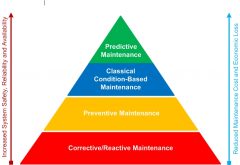Brief Introduction to PHM
Some asset, e.g., a washing machine, could be continuously used until it loses its function. Almost no maintenance is applied beforehand, because a failure of such an asset usually will not cause significant economic loss or fatal consequence. This type of maintenance is called “Corrective Maintenance” or “Reactive Maintenance” or “Run to Failure”, which implies that no repair or maintenance action is required prior to the occurrence of a failure; maintenance is only taken at a later time to ‘correct’ a failure. Some asset, e.g., a vehicle, must be regularly maintained according to either time or mileage to help ensure it is in a good health state; without a proper maintenance a vehicle could be dangerous. This type of maintenance is called “Preventive Maintenance”, which implies that maintenance is applied regularly to an asset to help prevent unexpected failures. Preventive maintenance is currently the most common maintenance that has been performed to devices, machines, aircrafts, equipment, and facilities that are all called assets.

Figure 1: Examples of assets that require maintenance.
Maintenance incurs cost and sometimes requires a shutdown of the asset or an interruption of the operation that causes inconvenience to our life or production. Up to this point, one may have a question: is it possible to minimize maintenance and meanwhile guarantee a good health state of an asset? The answer to this question is: yes, it is highly possible if “Condition-Based Maintenance” or “CBM” is adopted. Condition-based maintenance is not a new concept that can be traced back to 1950s. CBM refers to the fact that the health state of an asset is closely monitored in real time and maintenance is provided only when some fault is detected, or the health state of an asset degrades to a certain threshold. Taking the vehicle as an example, engine oil is regularly changed to help ensure a good health state of the car engine; however, one may find sometimes the waste engine oil is still in a good state because the vehicle was not driven that much in the past few months; if a CBM technology became available that could monitor the state of the engine oil, the engine maintenance service would likely be extended by three months or more, and this could save on both service cost and environment by minimizing oil change.
Condition-based maintenance offers possibility in minimizing maintenance while maximizing the availability and safety of an asset. In condition-based maintenance, a challenging topic is to accurately estimate the condition (i.e., the health state) of an asset, preferably in real time. The condition here refers to either past health condition, current health condition, or future health condition of the asset. Before 1990s, condition-based maintenance relies mainly on the past and current health conditions of an asset. However, starting from 1990s, extensive research started to consider including predicted future health condition of an asset in condition-based maintenance and this prediction-aided (or prediction-centered) “Condition-Based Maintenance” is termed specially as “Predictive Maintenance”. Predictive maintenance relies not only on the past and current health conditions of an asset that were/are monitored, but also on the future health condition that is prognosticated. The technologies and/or applications associated with predictive maintenance are typically called “Prognostics and Health Management” or in short “PHM”.

Figure 2: Pyramid of maintenance strategies.
While monitoring the past and current health conditions of an asset is already difficult, prognosticating the future health condition of an asset becomes even more challenging. PHM is a challenging and meanwhile promising engineering program that has seen a significant growth in the past twenty years. With tens of thousands of researchers and practitioners worldwide, nowadays, the applications for PHM are very broad encompassing aerospace, energy, manufacturing, defence, civil, automotive, transportation, communication, and health care. PHM methodologies possess potentials in providing effective means for reduction in cost associated with maintenance of complex systems, equipment, or facilities through accurate assessment of incipient damages, system degradation, and reliable prediction of remaining useful life at both component and system levels.
Applications of PHM
A PHM system is most desired in critical applications where safety, reliability, and availability are often major concerns. Critical applications could be safety-critical applications, cost-critical applications, volume-critical applications, or a combination of these three critical application scenarios. Safety-critical application means that a failure of an asset could be fatal, leading to loss of human lives or damages to environments, for instances, airplanes, nuclear reactors, and deep-water oil rig. Cost-critical applications implies that a failure of an asset could be very costly, leading to a significant amount of economic loss, for instances, spacecrafts, off-shore wind turbines, and cargo ships. Volume-critical application means that a failure of an asset could lead to the malfunction of a group of assets or the interruption of a great volume of process, for instance, manufacturing assembly lines and oil refinery facilities. All these critical applications can be simply named as mission-critical applications.
A typical PHM system usually consists of four functional modules: data acquisition and signal preprocessing module, condition monitoring and fault diagnostics module, failure prognostics module, and health management module. These modules are in a sequential order and may vary a bit from one application to another. A PHM system involves both software and hardware, requiring technologies from almost every single engineering discipline. For a researcher who is working on a research project in PHM, he may need to think of which technical point in a PHM functional module he likes to focus his research efforts on to bring some technical innovation or advancement to the field. In fact, there are many technical points to choose from in every single functional module, depending on one’s interest and background. No matter which technical point one likes to work on, technical innovation is often challenging and meanwhile inspiring for most researchers. Some technical innovations are very specific for certain applications, whereas other technical innovations could be more general for wider applications in the field. For an engineer who is planning to implement a PHM system for a specific application, he may need to think of what functional modules his PHM system should consist of and how complex and meanwhile advanced this PHM system would be. To answer these questions, he needs to understand his application scenario first, and then based on the resources (e.g., fund, technical readiness, hardware readiness, technical team, time, etc.) available make his decisions. In general, a PHM system could be simple and, in the meantime, less accurate, less reliable, and less capable as well. Conversely, a PHM system could be very complex, modern, reliable, and capable and in the meantime very costly and time-consuming in development and implementation. Trade-offs need to be made among complexity, functionality, capability, feasibility, cost, time, technical support, and technical readiness, etc., when dealing with a PHM system.
Many incidents happened in the past decade and these incidents could be potentially prevented if proper PHM systems could be implemented to the relevant assets. For example, the Deepwater Horizon Oil Spill that began on April 20, 2010 in the Gulf of Mexico killed 11 platform workers and injured 17 others. Approximately 53,000 barrels of crude oil per day were escaping from the well to ghe Gulf before it was capped on July 15, 2010. The spill caused extensive damage to marine and wildlife habitats as well as the Gulf’s fishing and tourism industries. As of 2018, cleanup costs, charges and penalties had cost BP Company more than $65 billion. It was reported that the central cause of this catastrophic explosion was failure of a cement barrier. Another example is related to a battery failure that had led airlines to stop flying all the 787 planes around the world for months in 2013. Most recently, two fatal Boeing 733 MAX crashes killed all the 346 passengers and crew members on board and grounded all the same aircrafts on the globe from March 2019. The investigation reports attributed the crashes to the maneuvering characteristics augmentation system pushing the aircraft into a dive due to data from a faulty angle-of-attack sensor. Catastrophic system failures are often attributed to critical component failures. PHM technologies provide good potentials in preventing unexpected system failure with real-time health monitoring of critical components; the PHM data and analysis results, in turn, can be fed back to the asset design team to help improve the system design.

Figure 3: Deepwater Horizon Oil Spill in Gulf of Mexico and battery failure on Boeing 787. (Photo Courtesy of Electrek.co and Medium.com)

Figure 4: Boeing 737 MAX passenger aircrafts crashed in Indonesia in 2018 and in Ethiopia in 2019. (Photo Courtesy of Fighter Jets World)